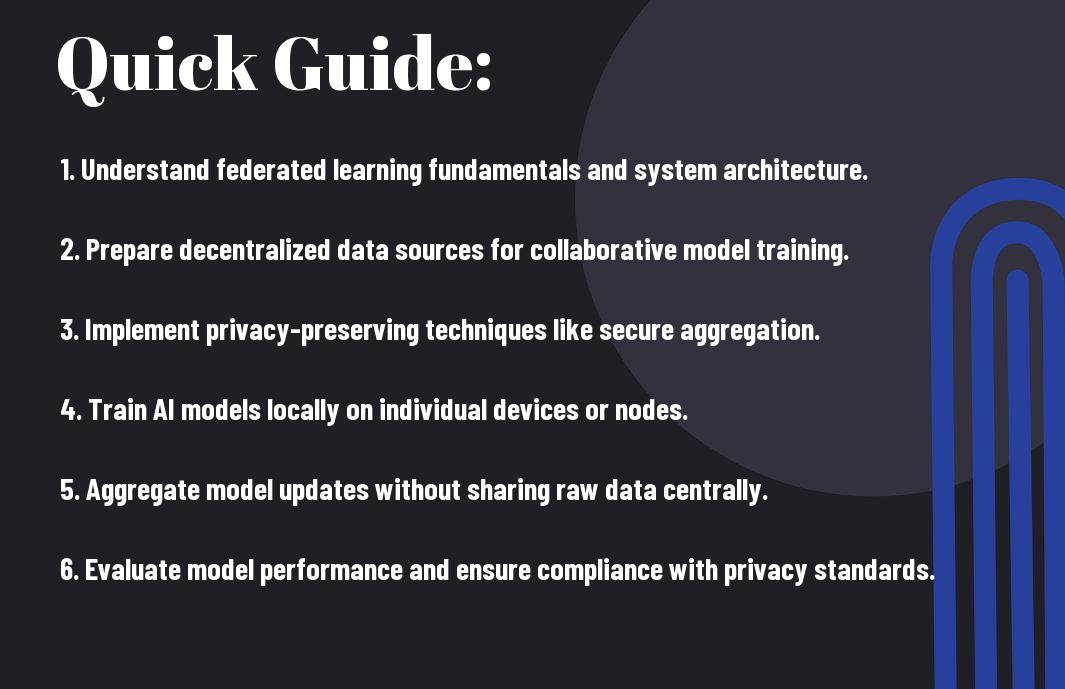Federated learning offers a groundbreaking approach to privacy in artificial intelligence by enabling your models to learn from decentralized data without compromising personal information. This method allows you to train your AI systems while keeping sensitive data on local devices, enhancing data security and user confidentiality. As you research into the principles and applications of federated learning, you’ll discover how to harness its potential to build advanced AI solutions that respect privacy rights while delivering impressive results.
Key Takeaways:
- Federated learning facilitates collaborative model training while keeping the data localized, enhancing user privacy by preventing central data storage.
- This approach allows multiple parties to contribute to AI model development without compromising sensitive information, thereby promoting trust and compliance with data protection regulations.
- Implementing federated learning can improve AI model performance by leveraging diverse datasets across different environments while retaining the confidentiality of individual data contributors.
The Mechanics of Federated Learning
Federated learning operates by decentralizing the training of machine learning models, allowing individual devices to contribute without transferring sensitive data to a central server. Instead, models are trained locally on each device using its own data. After local training, only the model updates—such as weights or gradients—are sent back to the central server. This process ensures that personal data remains on your device, significantly increasing privacy and security while still improving the global model’s performance through collaborative learning.
How Federated Learning Operates Without Centralized Data
In federated learning, the emphasis is on local computation, meaning your data stays on your device. A central server orchestrates the learning process by distributing the current model to various edge devices. Each device then trains this model using its local data and sends back the updates. These updates are aggregated to improve the global model, creating a synergy that refines accuracy while mitigating risks associated with centralized data storage.
The Role of Edge Devices in Data Processing
Edge devices are integral in the federated learning architecture; they take on the bulk of the computational workload. Your smartphone, tablet, or IoT device processes data locally, performing model training without the need for internet connectivity during this phase. By leveraging the power of edge devices, federated learning reduces latency and allows for real-time processing, crucial for applications requiring immediate feedback, such as healthcare diagnostics or personalized recommendations. This decentralized approach not only fosters individual privacy but also alleviates the burden on central servers, allowing them to operate more efficiently.

Fortifying Data Privacy: The Powers of Distribution
With federated learning, data privacy gains a robust backbone through the distribution of processing across multiple devices. Instead of aggregating sensitive data in one location, your model learns directly from your data where it’s generated, ensuring that personal information remains local and secure. This decentralized approach minimizes vulnerability points while still reaping the benefits of collective learning, making advancements in AI achievable without compromising privacy.
Breaking the Chains of Centralized Data Risks
The shift from centralized storage to federated learning dismantles the heavy reliance on data repositories prone to breaches. By keeping your data on individual devices, risks associated with mass data leaks significantly decrease. For instance, breaches that expose millions of records become irrelevant when each data piece remains on its originating device, leaving hackers with little to exploit.
Enhancing User Consent and Control Over Data
In federated learning, the power of consent shifts back to you. Unlike traditional models where data is simply collected and used, federated systems allow you to determine how your information is utilized, reinforcing your autonomy. This means that even while contributing to a broader dataset, you retain control over what, when, and how data is shared, ensuring your privacy preferences are respected.
Enhancing user consent and control also reflects a growing trend towards transparency in AI. Imagine being able to see a clear list of permissions for your data, and having the ability to toggle access based on your comfort level. You’re no longer just a passive contributor. Instead, you actively engage in decisions about your data, fostering a sense of trust with developers and organizations. This shift empowers you to better mitigate concerns regarding data misuse and enhances your confidence in the systems that utilize your information.

The Mathematics Behind Federated Learning Models
The foundation of federated learning lies in intricate mathematical frameworks that enable local models to be effectively aggregated into a global model. This decentralized approach utilizes algorithms such as FedAvg, which computes the weighted average of model updates from participating devices, ensuring that the collective knowledge is anchored in diverse data sources. By optimizing the performance of these models while preserving full data privacy, federated learning demonstrates how advanced mathematics can resolve significant challenges in artificial intelligence.
Algorithms and Their Distribution Dynamics
Various algorithms underpin the mechanics of federated learning, with their distribution dynamics playing a key role in maintaining data privacy while achieving robust model accuracy. Federated averaging, or FedAvg, serves as a cornerstone by selectively aggregating weights from multiple client-side models based on their local data distributions. You gain not only efficiency but also enhanced performance as these algorithms adapt to different data representations, fostering a more inclusive model development process.
Addressing Model Drifts and Convergence Issues
Model drift and convergence issues frequently arise in federated learning due to the heterogeneity of client data. Over time, the aggregate model may lose relevance as local data distributions shift, potentially impacting performance metrics. To combat this, strategies such as device participation scheduling and periodic global model updates are employed. Additionally, mechanisms like adaptive learning rates and differential privacy ensure the model remains aligned with current data trends while enhancing privacy protections.
To address model drifts and convergence issues effectively, incorporating techniques such as early stopping and retries can minimize the divergence between local and global models. Implementing methods like dynamic learning rates assists in fine-tuning model adjustments based on the feedback received during training iterations. Furthermore, utilizing meta-learning approaches enables models to better adapt to fluctuating data environments, leading to improved convergence rates. By continuously monitoring performance and making necessary adjustments, you can ensure that the federated learning model remains robust, accurate, and aligned with evolving data patterns, thus reinforcing its reliability in practical applications.
Regulatory Compliance: Navigating the Legal Landscape
As AI systems gain traction, adhering to a complex web of regulations becomes vital. Ensuring your AI models meet regulatory compliance can prevent hefty fines and reputational damage. Organizations like the European Union are leading the charge in developing strict guidelines for data usage and privacy. By proactively integrating compliance measures into your federated learning strategies, you not only protect your data but also enhance consumer trust, positioning your business as a responsible player in the AI landscape.
GDPR and Its Implications for AI Development
The General Data Protection Regulation (GDPR) significantly impacts AI development by mandating that organizations prioritize data privacy. You are required to ensure users have clear control over their personal data, including explicit consent and the right to withdrawal. Failing to align your AI solutions with GDPR can result in fines totaling up to €20 million or 4% of annual global turnover, emphasizing the importance of responsible data practices in your AI initiatives.
Federated Learning as a Solution for Data Sovereignty Challenges
Data sovereignty challenges arise when your organization operates across various jurisdictions with differing data use regulations. Federated learning offers a promising approach by allowing data to remain localized while still contributing to centralized model training. This method enables compliance with local laws, alleviating concerns about transferring sensitive data across borders. By leveraging federated learning, you can design AI systems that respect regional regulations and promote robust data privacy.
Federated learning effectively addresses data sovereignty issues by ensuring that sensitive information never leaves its original source. For instance, a healthcare provider in Germany can train AI algorithms on patient data without the need to transfer that data to a centralized server. By keeping the data on-site and only sending updates on the trained model back to a central location, you maintain compliance with stringent local regulations like GDPR. This approach not only minimizes the risk of unauthorized access but also fosters a culture of trust and accountability with your users, ensuring their data is handled with the utmost respect for privacy laws.
Real-World Applications: Privacy-Preserving Innovations
Federated learning spurs innovative applications across various domains, enhancing user data privacy while improving AI models. Revolutionary developments can be found in sectors such as healthcare, finance, and telecommunications. As highlighted in Privacy-first AI: Exploring Federated Learning, these innovations mark a significant shift towards responsible AI usage, ensuring users maintain control over personal information while reaping the benefits of advanced algorithms.
Transforming Healthcare Data Sharing with Federated Learning
Healthcare providers are leveraging federated learning to facilitate data sharing without compromising patient privacy. By training algorithms directly on local data, organizations can develop predictive models that enhance patient care without transferring sensitive health information. This method enables better diagnosis and treatment recommendations while ensuring compliance with healthcare regulations, safeguarding patient confidentiality.
Evaluating Security in Financial Transactions through AI
The financial sector embraces federated learning as a means to bolster security in transactions. AI models developed through this approach analyze decentralized transaction data, identifying fraud patterns while keeping personal financial details private. Such capabilities support banks and financial institutions in enhancing fraud detection mechanisms effectively.
In an evolving landscape where cyber threats loom large, federated learning helps fortify defenses in finance. Institutions adopting this methodology report improved accuracy in fraud detection, with studies indicating up to a 30% increase in identifying fraudulent activities compared to traditional methods. By avoiding the direct transfer of sensitive data, federated learning not only addresses privacy concerns but also allows for a more collaborative and secure approach to financial transactions. As trust builds, customers can engage more comfortably with financial services, knowing their information is safeguarded while benefiting from cutting-edge AI advancements.
Summing up
Summing up, exploring federated learning enables you to enhance data privacy in your AI models significantly. By leveraging this innovative approach, you can ensure that your models learn from data without compromising user privacy. Understanding the fundamentals and applications of federated learning empowers you to create more secure AI systems. For a deeper insight into implementing this privacy-preserving strategy, consider reviewing Federated Learning: A Privacy-Preserving Approach to ….
FAQ
Q: What is federated learning and how does it enhance data privacy in AI models?
A: Federated learning is a machine learning paradigm that allows multiple devices to collaboratively train a model while keeping the training data localized. Instead of sending all data to a central server, only the model updates are shared, which reduces the risk of exposing sensitive information. This decentralized approach ensures that individual data never leaves its source, thereby enhancing data privacy. By aggregating model gradients from various participants, federated learning maintains the comparative quality of AI models while preserving the privacy of individual datasets.
Q: What are some practical applications of federated learning that highlight its benefits for data privacy?
A: Several applications effectively demonstrate the advantages of federated learning for data privacy. One prominent example is in healthcare, where institutions can develop predictive models on patient data without sharing sensitive information across different hospitals. Another application is in mobile device personalization, where user data remains on the device while improving virtual assistants or recommendation systems. Additionally, financial institutions can collaborate on fraud detection models without compromising customer data privacy by using federated learning techniques to train models collectively while keeping transaction data secure.
Q: What challenges does federated learning face, and how can they be addressed to improve data privacy?
A: Federated learning encounters several challenges, including communication efficiency, model convergence, and data heterogeneity. One challenge is the potential for non-IID (Independent and Identically Distributed) data, which can lead to skewed models. This can be addressed by implementing strategies like personalized federated learning, where each participant can tailor the model to better fit their individual data. Moreover, optimizing network bandwidth through more efficient communication protocols can minimize the amount of data transmitted while ensuring quick updates. Additionally, integrating differential privacy techniques can help provide further protections against data leakage, effectively bolstering data privacy in federated learning scenarios.







